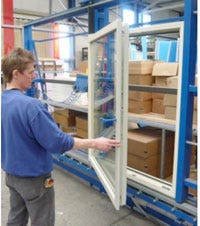According to officials at polyurethane (PUR) processing machinery manufacturer BBG (Mindelheim, Germany), which led the HWFF (German acronym for “highly-insulating windows and facade systems”) research project, their company already is in talks with window manufacturers on the construction of a first production line for commercial production of PUR window profiles.
July 30, 2009
According to officials at polyurethane (PUR) processing machinery manufacturer BBG (Mindelheim, Germany), which led the HWFF (German acronym for “highly-insulating windows and facade systems”) research project, their company already is in talks with window manufacturers on the construction of a first production line for commercial production of PUR window profiles. BBG intends to offer two differently sized processing cells, one suitable for output of up to 1.2 million linear profile meters per year and the second, smaller line for annual output from 200,000 meters onwards.
|
The larger line, called ContiPart, will allow for continuous automated production, but BBG reports its smaller SinglePart lines are drawing greater interest from the building and construction industry. The SinglePart manufacturing line can be equipped with molds for profile lengths from 4-6 meters and can be operated semi-automatically with the profiles fed and unloaded manually or with fully automatic feeding and loading. Eight encapsulation tools arranged in a carousel-shaped configuration on a rotating drum can be replaced independently of each other and can be fitted with molds for the production of different profile types.
Processing the profiles consists of several steps. After the profile cores are encapsulated in the molds, which are mounted on a rotating drum, they are cut to length, with spacers used to maintain the correct distance between core and sheath. The subsequent quality test is followed by a sheathing process in which the rigid-foam inner cores are coated with a 2-mm layer of impact-proof compact PUR foam in a second drum. After a short curing period, secondary operations such as painting of the profile cores can be completed. Eight 6-meter profiles can be produced in cycle times of 90 seconds each. Most vinyl profiles are extruded from pre-colored PVC, with no need for post-extrusion painting, and this certainly will be an issue before the PUR lines gain commercial status. BBG says its target price is around €1.5 million for the SinglePart line and about €3.6 million for the fully automatic ContiPart line.
BBG has devoted much of its development work in the past years to systems that use PUR to realize energy-saving products; it also has developed PUR processing lines for production of solar panels, for instance. During a trade show last autumn it displayed its “TopTherm 90” window (see photo), which is slender (width of 90 mm) and was offered in a triple glazing and in a “vacuum-thermopane” version. BBG claims this standard window is the world’s first with a polyurethane profile core and frame. The company says that tests early this year showed that PUR profiles are on par with PVC profiles in terms of impact strength and rain permeability statics and superior to vinyl in terms of heat insulation.
BBG is run by Hans Brandner, the managing partner, and the company predicts its 2009 revenue will reach €7.3 million. —[email protected]
About the Author(s)
You May Also Like



